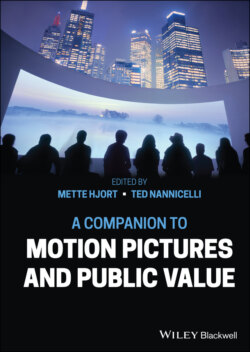Читать книгу A Companion to Motion Pictures and Public Value - Группа авторов - Страница 14
Approach
ОглавлениеAs the remit of the volume would suggest, the contributors hail from all over the world, geographically speaking, and all corners of the humanities (and, in some cases, beyond), institutionally speaking. The disciplines represented by the contributors include, of course screen studies (including film studies, television studies, media studies), as well as communications, cultural studies, environmental studies, literature, philosophy, and sociology. Among their number are three practitioners—that is, people for whom part of their job and professional identity is the creation of motion pictures.
On the one hand, the inclusion of practitioners (and scholar/practitioners) speaks to some of the practical aims of the project: We hope not just to describe the relationship between motion pictures and public value, but actively to contribute toward an ecology of motion pictures production that is driven by considerations of the common good. On the other hand, the pursuit of normative ideals or, indeed, values that are essentially normative demands some consideration of the nature of those ideals and values at a fairly general or abstract level. Typically, this sort of work falls within the purview of philosophy—in particular, “value theory,” which includes aesthetics and ethics.
Somewhere in between the practical concerns of implementing or realizing certain values in the production of motion pictures and the philosophers’ general questions about how to understand the nature and warrant of those values, there are a number of middle-level research questions to be asked about the historical relationship between motion pictures and public value, their contemporary relationship, and what their future relationship ought to look like. The sorts of questions we might pose at this middle-level of generality are diverse and answering them thus requires a diverse collection of methods. Some questions might require historical research, including, but not limited to archival research. Other questions might need to be addressed via close analysis of a specific group of motion pictures, and, depending on the research question, such a group might be defined by language, nation and/or origin (or reception), medium (or artform), mode of production (i.e., commercial, public, private, independent), and so forth. And still other questions involving the reception of motion pictures might need to appeal to the methods of the psychological sciences or of cultural studies, depending on what aspect of reception is under investigation.
What then, if anything, do the various methods and approaches taken by the contributors in this volume have in common? Arguably, it is their analytical orientation, as we suggested above. By “analytical,” we mean relating to analysis in the sense of a detailed and careful examination of a particular phenomenon. We might also add that in the chapters collected here, such analysis tends to be question- or problem-driven and the point or purpose of the analysis is clarificatory or explicative. In other words, although the project is explicitly underpinned by a commitment to particular ideas and values, this commitment exists at a quite general level and underdetermines the kinds of methodological or disciplinary-specific commitments that one might find in another edited collection. For example, our project might, methodologically speaking, be contrasted with an edited collection that was oriented around, say, actor-network theory; in such a volume, the contributors might be committed to a fairly specific doctrine and then proceed to offer a hermeneutic exploration of a text or group of texts on that basis. In contrast, the contributors to A Companion to Motion Pictures and Public Value tend to limit their doctrinal commitments and, instead, avail themselves of those methods or approaches that are most suited to exploring a particular research question or problem analytically in the sense described above.
